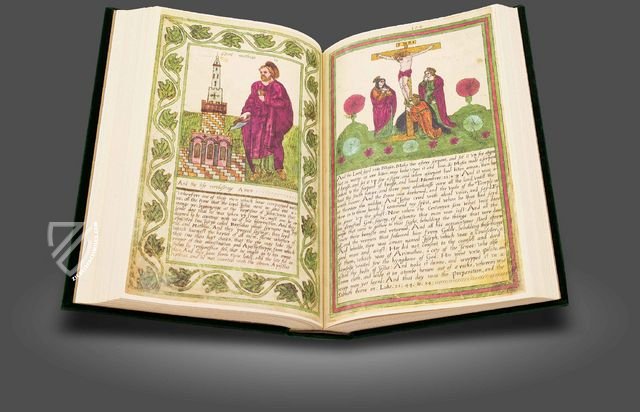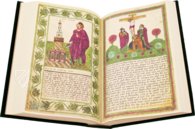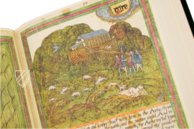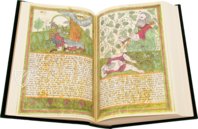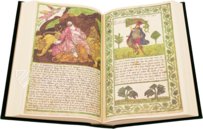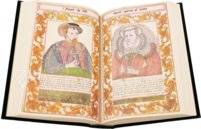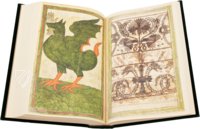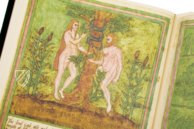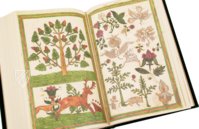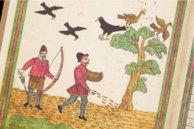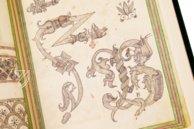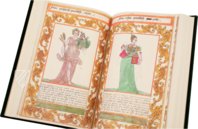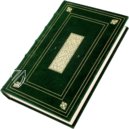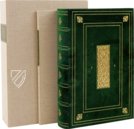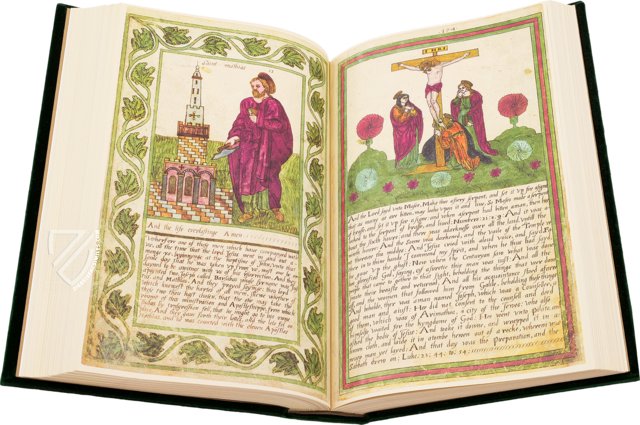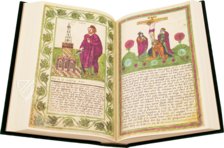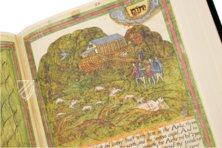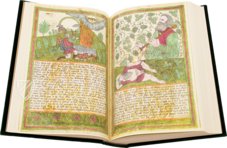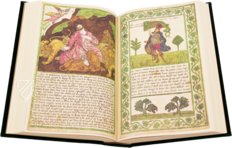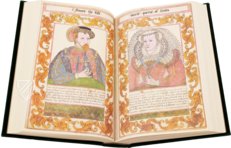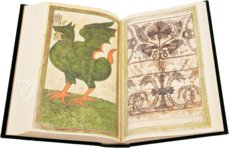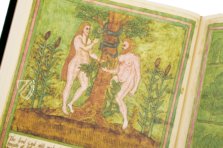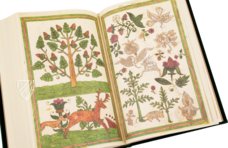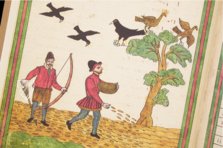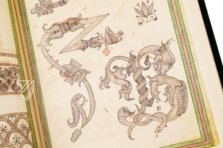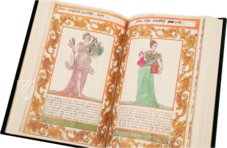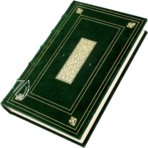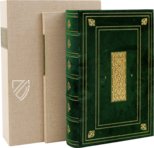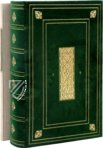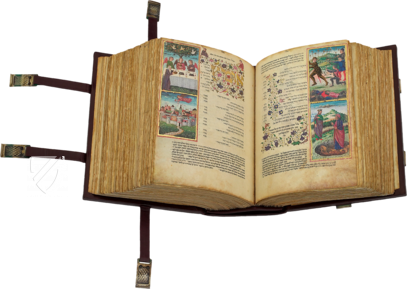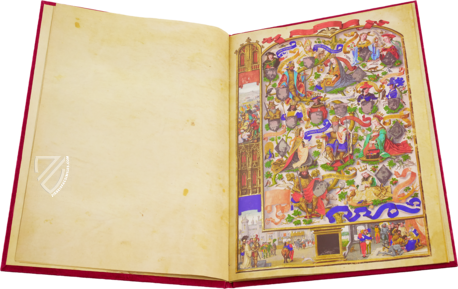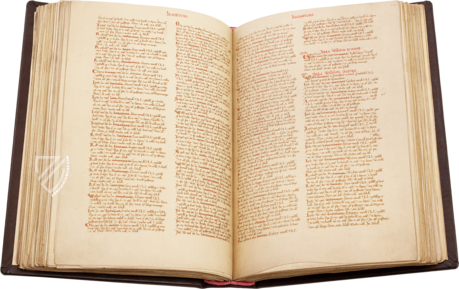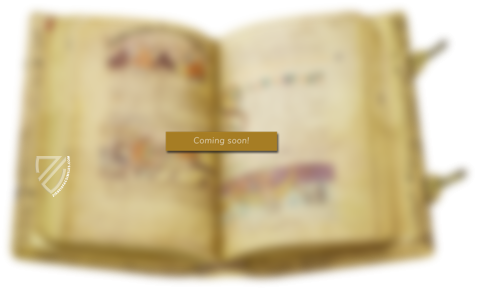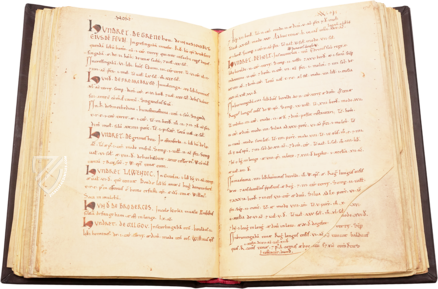Trevelyon Miscellany
(under 1,000€)
The Trevelyon Miscellany covers a fascinating range of texts on religious, historical, social and practical topics adapted from various sources. It is named after Thomas Trevelyon (born around 1548), who compiled the work in London in 1608 and provided it with numerous handwritten notes and extensive illustrations, many of which he richly colored and most of which were based on woodcuts and engravings. Divided into five parts, the manuscript is particularly well known for its artistic and delicate patterns for embroidery, needlework, woodwork and the like covering almost 100 pages. They bear witness to the profession and craftmanship of their creator, about whose life little else is known. Also noteworthy, however, are the many biblical depictions and, above all, the impressive portraits that accompany the genealogy of the descendants of William the Conqueror (ca. 1028–1087), including Queen Elizabeth I (1533–1603) and Mary Stuart (1542–1587).
Trevelyon Miscellany
Originating centuries after the invention of the printing press, this early-17th century manuscript is a rare example of a handwritten and illustrated codex from the Early Modern Period. Also known as the Folger Shakespeare Library MS V.b.232, the Trevelyon Miscellany of 1608 is the second of three manuscript miscellanies created by Thomas Trevelyon and is divided into five parts. It is essentially a compendium of information spanning information relevant to England and London in particular as well as Christendom more broadly but is most highly valued as an elaborate pattern book.
Miscelanious Contents
Part 1 consists of historical and practical information including a timeline, calendar, astronomical diagrams and other computational tables as well as a genealogy of William the Conqueror’s descendants and geographic information. A biblical chronology and genealogy as well as a list of British kings and queens is presented in Part 2 while Part 3 contains passages and lists from the Bible complete with illustrations. The most famous section of the manuscript is Part 4, consisting of patterns for embroidery, needlework, woodwork, etc. Many of these patterns are clearly rooted in artistic traditions going back as far as the Hiberno-Saxon art from the Early Middle Ages, the intricate interlace patterns in particular. Finally, Part 5 lists the sheriffs and mayors of London between the years 1190 and 1601.
A Mysterious Author
Thomas Trevelyon (b. ca. 1548) was a designer of embroidery patterns believed to be active in London between the years 1603 and 1616, the respective dates for the first and third editions. Interestingly, he spelled his surname differently in the various editions: “Trevelyon” in the Folger manuscript and “Trevilian” in the Wormsley Great Book. Almost nothing is known about the life of Thomas Trevelyon: not even the date of his death is established and what was once believed to be a self-portrait in the manuscript is actually a stock figure. However, this is consistent with the rest of the illustrations from Trevelyon’s hand, many of which are based on published woodcuts and copperplates.
Codicology
- Alternative Titles
- Trevelyon-Sammelband
Trevelyon Miscellany of 1608
Commonplace book
An Elizabethan pictorial and poetical manuscript commonplace book
Epitome of ancient and modern history - Type
- Manuscript on paper
- Size / Format
- 594 pages / 42,1 × 26.5 cm
- Origin
- United Kingdom
- Date
- 1608
- Epochs
- Style
- Genre
- Language
- Illustrations
- Miniatures on nearly every page, most of them half-page
- Previous Owners
- Richard Bull (1721–1806)
Richard Henry Alexander Bennet (d. 1814)
Lessing Julius Rosenwald
Trevelyon Miscellany
Queen Elizabeth I.
During her 44-year reign from 1558 to 1603, Queen Elizabeth I shaped an entire era of the British Empire - the "Elizabethan Age." During her reign, English Renaissance art, especially literature and theater, flourished. Moreover, the "Virgin Queen" succeeded in expanding the supremacy of her empire despite political, dynastic, religious and economic troubles. The arguably most powerful woman of 17th-century Europe appears here entirely adorned in gold. Her sweeping red dress is covered with golden borders, pearls and precious stones, and in her delicate hands she holds the imperial insignia as a matter of course.
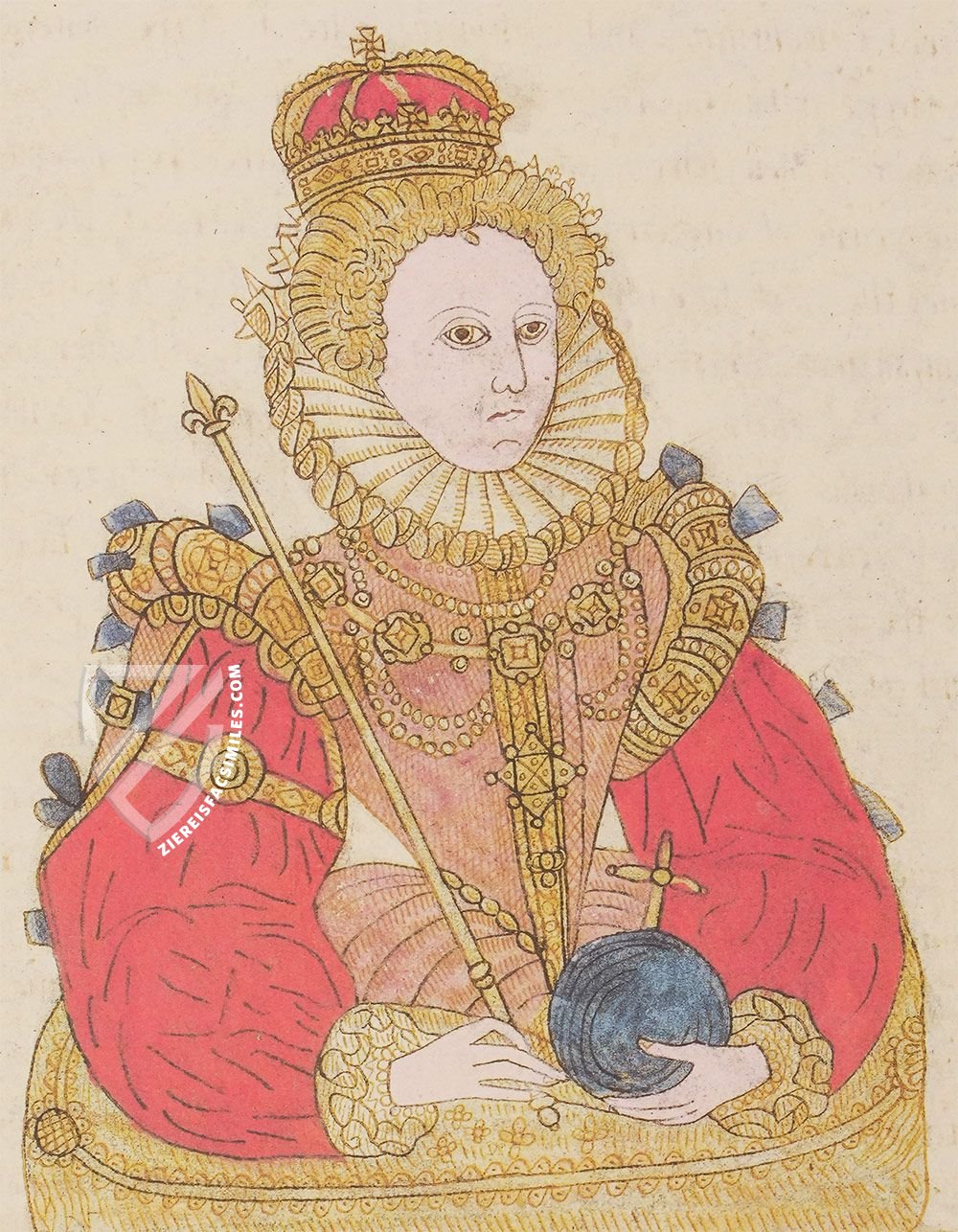
Trevelyon Miscellany
Justice
As one of the four cardinal virtues, justice is embedded in a wide frame of a uniform vegetal pattern with oak leaves. The characteristic depiction shows a woman holding a scale in her left hand, the right hand supports on a judgment sword. In accordance with the pictorial tradition since the 15th century, the Justitia is depicted with a blindfold. The three attributes represent the basic principles for a just administration of justice: Justice should be pronounced and enforced free from the prestige of any person (blindfold), after careful consideration (scales), and with the necessary severity (sword of justice). In addition, the Justitia is depicted in a meadow with various blue, red and yellow flowers, creating an overall artistic floral impression.
The half-page miniature is accompanied by parables and proverbs, as well as biblical and secular verses. In addition to justice, the other cardinal virtues are prudence, temperance and fortitude, which are followed by the theological virtues of love, hope and faith.
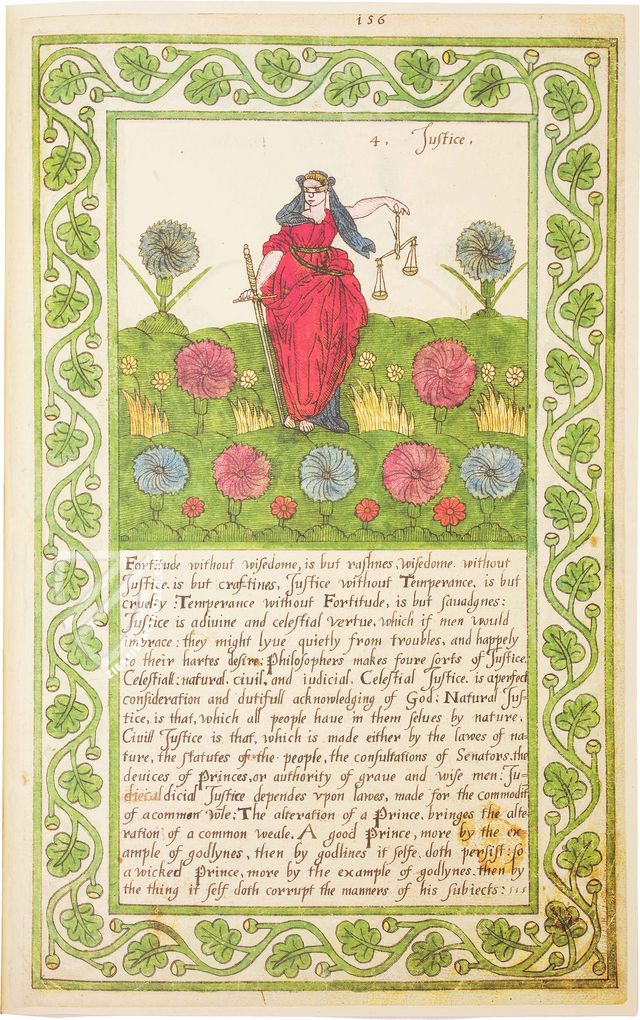
#1 The Trevelyon Miscellany of 1608
Language: English
(under 1,000€)
- Treatises / Secular Books
- Apocalypses / Beatus
- Astronomy / Astrology
- Bestiaries
- Bibles / Gospels
- Chronicles / History / Law
- Geography / Maps
- Saints' Lives
- Islam / Oriental
- Judaism / Hebrew
- Single Leaf Collections
- Leonardo da Vinci
- Literature / Poetry
- Liturgical Manuscripts
- Medicine / Botany / Alchemy
- Music
- Mythology / Prophecies
- Psalters
- Other Religious Books
- Games / Hunting
- Private Devotion Books
- Other Genres
- Afghanistan
- Armenia
- Austria
- Belgium
- Belize
- Bosnia and Herzegovina
- China
- Colombia
- Costa Rica
- Croatia
- Cyprus
- Czech Republic
- Denmark
- Egypt
- El Salvador
- Ethiopia
- France
- Germany
- Greece
- Guatemala
- Honduras
- Hungary
- India
- Iran
- Iraq
- Israel
- Italy
- Japan
- Jordan
- Kazakhstan
- Kyrgyzstan
- Lebanon
- Liechtenstein
- Luxembourg
- Mexico
- Morocco
- Netherlands
- Palestine
- Panama
- Peru
- Poland
- Portugal
- Romania
- Russia
- Serbia
- Spain
- Sri Lanka
- Sweden
- Switzerland
- Syria
- Tajikistan
- Turkey
- Turkmenistan
- Ukraine
- United Kingdom
- United States
- Uzbekistan
- Vatican City
- A. Oosthoek, van Holkema & Warendorf
- Aboca Museum
- Ajuntament de Valencia
- Akademie Verlag
- Akademische Druck- u. Verlagsanstalt (ADEVA)
- Aldo Ausilio Editore - Bottega d’Erasmo
- Alecto Historical Editions
- Alkuin Verlag
- Almqvist & Wiksell
- Amilcare Pizzi
- Andreas & Andreas Verlagsbuchhandlung
- Archa 90
- Archiv Verlag
- Archivi Edizioni
- Arnold Verlag
- ARS
- Ars Magna
- ArtCodex
- AyN Ediciones
- Azimuth Editions
- Badenia Verlag
- Bärenreiter-Verlag
- Belser Verlag
- Belser Verlag / WK Wertkontor
- Benziger Verlag
- Bernardinum Wydawnictwo
- BiblioGemma
- Biblioteca Apostolica Vaticana (Vaticanstadt, Vaticanstadt)
- Bibliotheca Palatina Faksimile Verlag
- Bibliotheca Rara
- Boydell & Brewer
- Bramante Edizioni
- Bredius Genootschap
- Brepols Publishers
- British Library
- C. Weckesser
- Caixa Catalunya
- Canesi
- CAPSA, Ars Scriptoria
- Caratzas Brothers, Publishers
- Carus Verlag
- Casamassima Libri
- Centrum Cartographie Verlag GmbH
- Chavane Verlag
- Christian Brandstätter Verlag
- Circulo Cientifico
- Club Bibliófilo Versol
- Club du Livre
- CM Editores
- Collegium Graphicum
- Collezione Apocrifa Da Vinci
- Comissão Nacional para as Comemorações dos Descobrimentos Portugueses
- Coron Verlag
- Corvina
- CTHS
- D. S. Brewer
- Damon
- De Agostini/UTET
- De Nederlandsche Boekhandel
- De Schutter
- Deuschle & Stemmle
- Deutscher Verlag für Kunstwissenschaft
- DIAMM
- Droz
- E. Schreiber Graphische Kunstanstalten
- Ediciones Boreal
- Ediciones Grial
- Ediclube
- Edições Inapa
- Edilan
- Editalia
- Edition Deuschle
- Edition Georg Popp
- Edition Leipzig
- Edition Libri Illustri
- Editiones Reales Sitios S. L.
- Éditions de l'Oiseau Lyre
- Editions Medicina Rara
- Editorial Casariego
- Editorial Mintzoa
- Editrice Antenore
- Editrice Velar
- Edizioni Edison
- Egeria, S.L.
- Eikon Editores
- Electa
- Emery Walker Limited
- Enciclopèdia Catalana
- Eos-Verlag
- Ephesus Publishing
- Ernst Battenberg
- Eugrammia Press
- Extraordinary Editions
- Fackelverlag
- Facsimila Art & Edition
- Facsimile Editions Ltd.
- Facsimilia Art & Edition Ebert KG
- Faksimile Verlag
- Feuermann Verlag
- Folger Shakespeare Library
- Franco Cosimo Panini Editore
- Friedrich Wittig Verlag
- Fundación Hullera Vasco-Leonesa
- G. Braziller
- Gabriele Mazzotta Editore
- Gebr. Mann Verlag
- Gesellschaft für graphische Industrie
- Getty Research Institute
- Giovanni Domenico de Rossi
- Giunti Editore
- Graffiti
- Grafica European Center of Fine Arts
- Guido Pressler
- Guillermo Blazquez
- Gustav Kiepenheuer
- H. N. Abrams
- Harrassowitz
- Harvard University Press
- Helikon
- Hendrickson Publishers
- Henning Oppermann
- Herder Verlag
- Hes & De Graaf Publishers
- Hoepli
- Holbein-Verlag
- Houghton Library
- Hugo Schmidt Verlag
- Idion Verlag
- Il Bulino, edizioni d'arte
- ILte
- Imago
- Insel Verlag
- Insel-Verlag Anton Kippenberger
- Instituto de Estudios Altoaragoneses
- Instituto Nacional de Antropología e Historia
- Introligatornia Budnik Jerzy
- Istituto dell'Enciclopedia Italiana - Treccani
- Istituto Ellenico di Studi Bizantini e Postbizantini
- Istituto Geografico De Agostini
- Istituto Poligrafico e Zecca dello Stato
- Italarte Art Establishments
- Jan Thorbecke Verlag
- Johnson Reprint Corporation
- Josef Stocker
- Josef Stocker-Schmid
- Jugoslavija
- Karl W. Hiersemann
- Kasper Straube
- Kaydeda Ediciones
- Kindler Verlag / Coron Verlag
- Kodansha International Ltd.
- Konrad Kölbl Verlag
- Kurt Wolff Verlag
- La Liberia dello Stato
- La Linea Editrice
- La Meta Editore
- Lambert Schneider
- Landeskreditbank Baden-Württemberg
- Leo S. Olschki
- Les Incunables
- Liber Artis
- Library of Congress
- Libreria Musicale Italiana
- Lichtdruck
- Lito Immagine Editore
- Lumen Artis
- Lund Humphries
- M. Moleiro Editor
- Maison des Sciences de l'homme et de la société de Poitiers
- Manuscriptum
- Martinus Nijhoff
- Maruzen-Yushodo Co. Ltd.
- MASA
- Massada Publishers
- McGraw-Hill
- Metropolitan Museum of Art
- Militos
- Millennium Liber
- Müller & Schindler
- Nahar - Stavit
- Nahar and Steimatzky
- National Library of Wales
- Neri Pozza
- Nova Charta
- Oceanum Verlag
- Odeon
- Orbis Mediaevalis
- Orbis Pictus
- Österreichische Staatsdruckerei
- Oxford University Press
- Pageant Books
- Parzellers Buchverlag
- Patrimonio Ediciones
- Pattloch Verlag
- PIAF
- Pieper Verlag
- Plon-Nourrit et cie
- Poligrafiche Bolis
- Presses Universitaires de Strasbourg
- Prestel Verlag
- Princeton University Press
- Prisma Verlag
- Priuli & Verlucca, editori
- Pro Sport Verlag
- Propyläen Verlag
- Pytheas Books
- Quaternio Verlag Luzern
- Reales Sitios
- Recht-Verlag
- Reichert Verlag
- Reichsdruckerei
- Reprint Verlag
- Riehn & Reusch
- Roberto Vattori Editore
- Rosenkilde and Bagger
- Roxburghe Club
- Salerno Editrice
- Saltellus Press
- Sandoz
- Sarajevo Svjetlost
- Schöck ArtPrint Kft.
- Schulsinger Brothers
- Scolar Press
- Scrinium
- Scripta Maneant
- Scriptorium
- Shazar
- Siloé, arte y bibliofilia
- SISMEL - Edizioni del Galluzzo
- Sociedad Mexicana de Antropología
- Société des Bibliophiles & Iconophiles de Belgique
- Soncin Publishing
- Sorli Ediciones
- Stainer and Bell
- Studer
- Styria Verlag
- Sumptibus Pragopress
- Szegedi Tudomànyegyetem
- Taberna Libraria
- Tarshish Books
- Taschen
- Tempus Libri
- Testimonio Compañía Editorial
- Thames and Hudson
- The Clear Vue Publishing Partnership Limited
- The Facsimile Codex
- The Folio Society
- The Marquess of Normanby
- The Richard III and Yorkist History Trust
- Tip.Le.Co
- TouchArt
- TREC Publishing House
- TRI Publishing Co.
- Trident Editore
- Tuliba Collection
- Typis Regiae Officinae Polygraphicae
- Union Verlag Berlin
- Universidad de Granada
- University of California Press
- University of Chicago Press
- Urs Graf
- Vallecchi
- Van Wijnen
- VCH, Acta Humaniora
- VDI Verlag
- VEB Deutscher Verlag für Musik
- Verlag Anton Pustet / Andreas Verlag
- Verlag Bibliophile Drucke Josef Stocker
- Verlag der Münchner Drucke
- Verlag für Regionalgeschichte
- Verlag Styria
- Vicent Garcia Editores
- W. Turnowski Ltd.
- W. Turnowsky
- Waanders Printers
- Wiener Mechitharisten-Congregation (Wien, Österreich)
- Wissenschaftliche Buchgesellschaft
- Wissenschaftliche Verlagsgesellschaft
- Wydawnictwo Dolnoslaskie
- Xuntanza Editorial
- Zakład Narodowy
- Zollikofer AG

